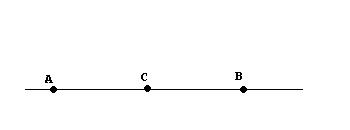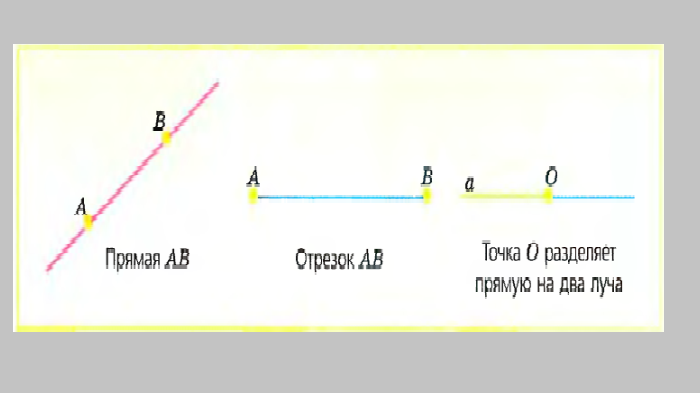What geometric figure is the beginning of the ray. What is a ray in mathematics and geometry
Along with such concepts as point, segment, line, there is one more concept in geometry. It is called ray. A ray is a part of a straight line, limited on one side by a point, and on the other side - infinite, i.e. not limited by anything.
An analogy can be drawn with nature. For example, a beam of light that we can direct from earth into space. On the one hand it is limited, but on the other hand it is not. Each ray has one extreme point at which it begins. It is called beginning of the ray.
If we take an arbitrary straight line a, and mark some point on it ABOUT, then this point will split our line into two parts. Each of which will be a ray. Point O will belong to each of these rays. Point O will be at in this case the beginning of these two rays.
The beam is usually designated by one Latin letter. The figure below shows ray k.

You can also denote a ray with two large in Latin letters. In this case, the first of them is the point at which the beginning of the beam lies. The second is the point that belongs to the ray, or in other words, through which the ray passes.

The figure shows the OS beam.
Another way to designate a ray is to indicate the starting point of the ray and the line to which this ray belongs. For example, the figure below shows the ray Ok.

Sometimes they say that the ray comes from point O. This means that point O is the beginning of the ray. Rays are also sometimes called semi-straight.
Task:
Draw a straight line and mark points A B on it and mark point C on segment AB. Among the rays AB, BC, CA, AC and BA, find pairs of coinciding rays.
Solution:
The rays coincide if they lie on the same straight line and have a common origin and none of them is a continuation of another ray.
The figure shows that these conditions are met by rays AB and AC, as well as rays BC and BA. Therefore, they are coincident.

Answer: AB and AC, BC and BA.
From the school geometry course, few people have accurate information about what a segment is, how it is designated, what a broken line, a straight line, a point are, and how rays are designated. If you cannot remember the initial geometry course, just read this article.
What is geometry? This is a mathematical section in which the student gets acquainted with geometric figures and their properties. There is a lot of information, sometimes there is not enough time to take in and remember everything. Some knowledge needs to be refreshed after several months and even years. For example, remember what rays are and how they are designated.
What is a ray in geometry
A ray is a straight line, limited on one side by a point, and on the other hand free, that is, without restrictions. To quickly remember how rays are designated and what they look like, you can give a simple example: we can direct a beam of light from a flashlight into the sky, right? On one side, the beam is limited - from the place where it comes out, that is, from the flashlight. On the other hand, it has no restrictions. It turns out that there is only one extreme point of the beginning of the ray, it is called the “beginning”. The second point does not exist, because the beam goes to infinity.
To understand how to mark a ray on a piece of paper, you need to draw a straight line. For example, let it be a segment equal to 10 cm. C right side let's set a limit - a point, this is the beginning of the ray. There will be no second point at the end of the segment.
How are the rays designated?
Let's continue to remember what a ray is and how to designate it.
There are several designation options:
- Let's draw a straight line in a notebook and mark the point of origin of the ray. And let's give it a name. For example, let it be beam "C". The first point is the beginning of the ray; the second point, as you already remembered, does not exist. This is the classic ray notation scheme.
- The second option is more interesting: the beam can be designated by several letters. For example, there can be 2 letters on one beam. The first is the beginning of the beam, let it be the letter A, and the second can be located with a certain step. Let’s say that on a segment 10 cm long, the beginning of the ray is designated by the letter A, and at a distance of 4 cm from the beginning of the ray there is a second point, point B. Then the ray should be designated as ray “AB”. To make it clearer, you can read it like this: the second point B is the point through which the ray passes.
- The rays can also be designated in a third way, when the starting point is not at the beginning of the ray, but with a slight deviation. For example, draw a straight line 10 cm long, step back 1 cm from the left edge, put a dot - this will be the beginning of the ray. We denote, for example, the letter O. We do not put a point in the middle of the ray, but we denote this part of the ray with the letter K. In this case, the letter O will be the beginning of this ray, it comes from this point. The beam is read like this: “OK”, it is semi-direct.

How is a beam indicated in a notebook?
The designation on the letter of the ray must be remembered once: the rays are written in Latin capital letters. If it is a straight line, then you need to write the ray AB in parentheses: (AB). If you have a segment in front of you, then it is written only in square brackets.

Along with such concepts as point, segment, line, there is one more concept in geometry. It is called ray. A ray is a part of a straight line, limited on one side by a point, and on the other side - infinite, i.e. not limited by anything.
An analogy can be drawn with nature. For example, a beam of light that we can direct from earth into space. On the one hand it is limited, but on the other hand it is not. Each ray has one extreme point at which it begins. It is called beginning of the ray.
If we take an arbitrary straight line a, and mark some point on it ABOUT, then this point will split our line into two parts. Each of which will be a ray. Point O will belong to each of these rays. Point O will be in this case the beginning of these two rays.
The beam is usually designated by one Latin letter. The figure below shows ray k.

You can also denote the beam with two capital Latin letters. In this case, the first of them is the point at which the beginning of the beam lies. The second is the point that belongs to the ray, or in other words, through which the ray passes.

The figure shows the OS beam.
Another way to designate a ray is to indicate the starting point of the ray and the line to which this ray belongs. For example, the figure below shows the ray Ok.

Sometimes they say that the ray comes from point O. This means that point O is the beginning of the ray. Rays are also sometimes called semi-straight.
Task:
Draw a straight line and mark points A B on it and mark point C on segment AB. Among the rays AB, BC, CA, AC and BA, find pairs of coinciding rays.
The rays coincide if they lie on the same straight line and have a common origin and none of them is a continuation of another ray.
The figure shows that these conditions are met by rays AB and AC, as well as rays BC and BA. Therefore, they are coincident.



















